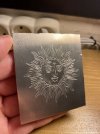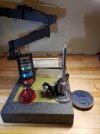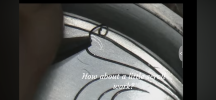vondershred
Member
- Joined
- Feb 21, 2024
- Messages
- 32
Hey y’all, it’s me again!
Quick question about graver geometry. After some digging on Youtube and this forum I’m led to believe that graver geometry plays a huge part in the colour of the lines you engrave. Can someone confirm?
I learned how smaller the angle for instance a 60 degree angle makes the lines bright and shiny, whereas a 120 degree angle results in dark lines. Makes a lot of sense since I did my fourth practice plate yesterday with a flat 0.4mm graver (no angle) and all the lines are bright (see picture). All my previous practice plates are like this too, since I only have flat gravers at my disposal for now.
Up until now I thought there was no connection and all lines with all graver angles are bright and you have to ink them to make ‘em black, but I saw lots of Sam Alfano’s vids where the lines are black-ish when fresh cut and he sometimes mentions he likes the 120 degree gravers best. This is more the look I’m after. This would also eliminate the need to make a mess with black enamel paint. Tried that yesterday and boy did it suck. I know now this technique is rather used for filling removed background rather than fill lines, the lines being black already when fresh cut.
Also, does the type of metal make a difference too? Engraving on aluminum now…
Thanks guys,
Tristan.

Quick question about graver geometry. After some digging on Youtube and this forum I’m led to believe that graver geometry plays a huge part in the colour of the lines you engrave. Can someone confirm?
I learned how smaller the angle for instance a 60 degree angle makes the lines bright and shiny, whereas a 120 degree angle results in dark lines. Makes a lot of sense since I did my fourth practice plate yesterday with a flat 0.4mm graver (no angle) and all the lines are bright (see picture). All my previous practice plates are like this too, since I only have flat gravers at my disposal for now.
Up until now I thought there was no connection and all lines with all graver angles are bright and you have to ink them to make ‘em black, but I saw lots of Sam Alfano’s vids where the lines are black-ish when fresh cut and he sometimes mentions he likes the 120 degree gravers best. This is more the look I’m after. This would also eliminate the need to make a mess with black enamel paint. Tried that yesterday and boy did it suck. I know now this technique is rather used for filling removed background rather than fill lines, the lines being black already when fresh cut.
Also, does the type of metal make a difference too? Engraving on aluminum now…
Thanks guys,
Tristan.

Last edited:








